Episode 20 – Madu Road National Park

Confronting death
I joined the Department of Wildlife Conservation on 1st October 2004. I had to serve in North West and Anuradhapura North areas. This is a large area; it covers fairly about half of Sri Lanka’s wilderness and it is very difficult as well. At that time, most of the areas on this side were controlled by the LTTE. Therefore, there were very few veterinary surgeons served there.
Because of the presence of LTTE in this area, there was a great threat to life. Always sounds of shootings were frequent. Mines were planted almost everywhere. We had to move around about 200-300 km per day to rescue animals. We must go anywhere only with the permission of the Sri Lanka Army. The Army search operations were carried out sometimes for hours. The procedures to get permission were bit longer. Certain days we had to stay in military camps. Mostly, we had to go to treatment with military assistance. The army also does not like to walk much because of landmines. We did not tell our homes about this situation.
In early 2008, there was an elephant that was attacking people in Vedithalau area. This elephant started killing people. The Department of Wildlife decided to capture the elephant. The elephant roams over a considerable area. Out of that, some areas are manifested with land mines, considerable areas were de-mined and some areas were occupied by the LTTE.
We had a team of about twenty people for such operations. Veterinary Surgeon, Dharmakirthi was also there. On that day, we anesthetized the elephant, caught it, loaded it into a truck and took it to another area with the hope of releasing it.
We left with the group around 7:00 that morning. There were about 15 to 20 army men with us. Several vehicles and a lorry were taken for the operation. We saw the elephant inside the Wetkalathivu forest. The elephant was in a mine-free area. After we injected the elephant with anesthetic drug, it ran about 500 meters to the direction of the mine-laden area. When we followed and found the elephant with difficulty, we saw the elephant lying down. If we don’t do the reverse anesthesia, the elephant will die. There is no other option but to go there. As per the instructions of the Army, we walked along the road where the elephant had stepped and went there. After being de-anesthetized, the elephant was tied to a rope and dragged to the mine-free area with the help of a backhoe. Then they loaded it into the vehicle with difficulty and left the area safely.
Another incident happened in this area. The country was peaceful then. The Vavuniya District Secretariat notified that an elephant had fallen into a well in LTTE control area, it has been informed by the LTTE. The Vavuniya District Secretariat coordinated between us and the LTTE. A group of 5-6 of us took permission from the army and left. District Forest Officer of Vavuniya, Mr. Herath was also with us. There is no army beyond one place and the area was under the control of LTTE. There was no one in the street. Armed persons were looking at us everywhere. The Women’s Corps were also present. There were many child soldiers also. We were very scared.
They don’t know Sinhala language and we can’t understand Tamil also. We talked in English with people who could speak a little English. They checked our vehicle. In addition to the anesthetic guns, the vehicle had a repeater gun, under the rug. They did not see it. LTTE cadres left with us on two motorbikes each in front and behind. Each man had two weapons.
During this visit, we saw LTTE camps covered with iron plates. Tractors were also parked there. Meantime, we met an Engineer who studied with me at Peradeniya University while they were renovating roads. He coordinated for us. When going to the place, a large group of villagers had gathered. The elephant has fallen into a deep well. When looking from above, the elephant looked small and white. It has been in the well for about 10 days.
It was well lined with granite. Those persons objected to breaking the well. I asked our men to draw water from a nearby well. Later, he found a motor and filled this well from a nearby well. When the water was full, the elephant came up. Then the elephant crawled and came to the land. As soon as it comes out from the well, fallen down lifeless due to weakness.
We gave the elephant 4-5 bottles of saline. Suddenly the elephant got up. We all ran directions where our heads turned. The LTTE cadres also took weapons and ran. I hid behind a tree and I found an LTTE cadre was also there. He started shooting up. After I said not to do so he stopped. Here I took out our repeater gun. LTTE cadre was worried because he had not seen the weapon before. But they were explained that we will carry the repeater gun anyway in such operations. They checked it thoroughly.
Later LTTE They gave us rice with brinjals and bush meat. Although not tasty, it was Ok. We were taken to their so-called political leader. I don’t remember his name now. He gave us a lecture on animal welfare. After leaving there, we came to the army camp. The army was not happy about our journey. When we came back that day, it was around twelve at night. Later I came to know that two people from the LTTE intelligence wing had also searched for details about me.
These two events are among unforgettable wild memories of my life.
Veterinary Surgeon, Dr. Chandana Jayasinghe

Mr. ChandanaJayasinghe, was selected for the service of the Wildlife Department through a competitive examination and joined the service as a veterinarian on 01.10.2004, he completed his veterinary degree from University of Peradeniya. A post graduate in environmental science, Mr. Jayasinghe also completed a Diploma in ‘Wildlife & Rehabilitation’ in USA.
Veterinary Surgeon Mr. ChandanaJayasinghe, who works in a remote area in Anuradhapura North-West and a Northern area, has a wealth of experience in field of Wildlife.
He is a father of two sons and a daughter. His wife Kalani works as a dance teacher at Central College, Anuradhapura, while both of his two sons study at St. Joseph’s College and daughter at Swarnapali Girls’ College.
Their address is 186/1, SubhasadhakaMawatha, Vijaypura, Anuradhapura.
Madu Road National Park
Designated as a sanctuary on June 28, 1968 under the Fauna and Flora Protection Ordinance, 1937, the Madhu Road area is located about 25 kilometers East of Mannar in the Northern Province of Sri Lanka. The sanctuary covers an area of 103 square miles and is located in the Mantai East, Mantai South, Chenkalaveddy and Vavuniya South (Tamil) Divisional Secretariat Divisions of Mannar, Mullaitivu and Vavuniya Districts of the Northern Province. After the end of the civil war in Sri Lanka, in view of illegal sand mining, soil removal and development activities spread without government control, several sanctuaries in the Northern Province were planned to be turned into National Parks. Accordingly, it was recommended by the Joint Strategic Environmental Assessment of the Northern Province, which was published by the government in October 2014, with the support of the United Nations Development Program and the United Nations Environment Program (UNDP), the Madu Road Sanctuary and its surrounding forests, except for developed areas, are designated as National Park. Accordingly, recognizing its biodiversity, the government declared Madupara, Adam’s Bridge, Chundikkulam and Delft Forests as National Parks. Accordingly, Madupara Sanctuary with an area of 163,067.39 hectares has been gazetted as a National Park on 22 June 2015 under No.1920/3.

The shrine of Our Lady of Madu, a more than 400-year-old Roman Catholic St. Mary’s Church, which is a holy Catholic shrine in Sri Lanka, can also be seen near the MaduRoad National Park.
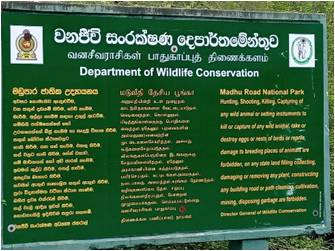
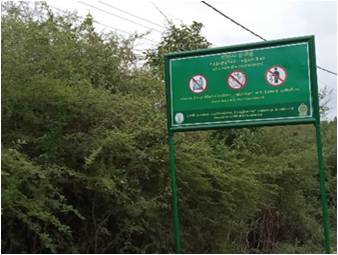
Weera (Drypetes sepiaria), Stain (Chloroxylon swietenia), Kohomba (Azadirachta indica), Banyan (Ficus benghalensis), Kalumadiriya (Diospyros quaesita) can be identified as the dominant plant species found in the park. Madu Road is home to various bird species as well.

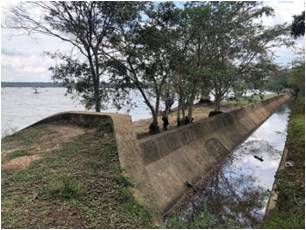
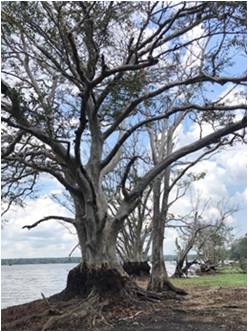
Various species of animals live in this park because of the favorable environment for them. Among the animal species found here, Sri Lankan Gray hornbill (Ocyceros gingalensis), Blue-faced malkoha (Phaenicophaeus viridirostris), Brown-Capped Barbbler (Pellorneum fuscocapillus), SL Crimson-Fronted Barbet (Psilopogon rubricapillus), Sri Lanka junglefowl (Gallus lafayetii), S.L Wood shrike (Tephrodornis affinis), Malabar pied hornbill (Anthracoceros coronatus), Brahmin kite (Haliastur indus) are the bird species.
Madu Road Park is home to a significant number of wild elephants and there is also an elephant corridor through the Madupara area. Asian elephant (Elephas maximus), Sloth bear (Melursus ursinus), Leopard (Panthera pardus kotiya), Water buffalo (Bubalus bubalis), Wild Boar (Sus scrofa) are the main ones found in the park. Small mammals like giant squirrel (Ratufa macroura), golden jackal (Canis aureus), common langur (Semnopithecus entellus), common mongoose (Herpestes edwardsii), Indian hare (Lepus nigricollis) are also sheltered in the forest.
Madu Road National Park is not yet open to tourists as it was recently designated as a National Park.
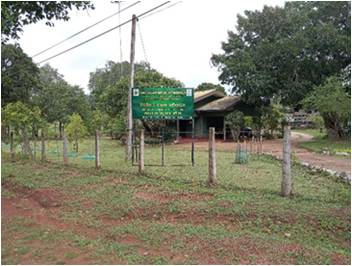
List of animals in the Madu Road National Park
Sinhala Names | Tamil Names | English Names | Scientific Name |
කොටියා | சிறுத்தை | Leopard | Panthera pardus kotiya |
වලහා | தேன் கரடி | Sloth bear | Melursus ursinus |
අලියා | ஆசிய யானை | Asian elephant | Elephas maximus |
වල් මී හරකා | காட்டெருமை | Water buffalo | Bubalus bubalis |
වල් ඌරා | காட்டுப்பன்றி | Wild Boar | Sus scrofa |
| හිවලා | நரி | Golden Jackal | Canis aureus |
අළු වදුරා | சாம்பல் முகக் குரங்கு | Common langur | Semnopithecus entellus |
හාවා | இந்தியகுழி முயல் | Indian hare | Lepus nigricollis |
මුගටියා | இந்திய சாம்பல் கீரிப்பிள்ளை | Common Mongoose | Herpestes edwardsii |
දඬු ලේනා | பழுப்பு மலை அணில் | Giant squirrel | Ratufa macroura |
ශ්රී ලංකා අළුකෑදැත්තා | இலங்கை சாம்பல் இருவாய்ச்சி | Sri lanka Grey Hornbill | Ocyceros gingalensis |
වත නිල් මල් කොහා | நீல முகச் செண்பகம் | Blue – faced malkoha | Phaenicophaeus viridirostris |
ලංකා මුදුන් බොර දෙමලිච්චා | பழுப்பு நிற மூடிய புளுணி | Brown- Capped Barbbler | Pellorneum fuscocapillus |
ශ්රී ලංකා මල් කොට්ටෝරුවා | சின்ன குக்குறுவான் | SL Crimson-Fronted Barbet | Psilopogon rubricapillus |
වළි කුකුලා | இலங்கைக்காட்டுக்கோழி | Sri lankajunglefowl | Gallus lafayetii |
පොදුවනසැරටින්නා | இலங்கைவுட்ஷ்ரைக் | S.L Wood shrike | Tephrodornis affinis |
පොරෝ කෑදැත්තා | மலபார்கறுப்புவெள்ளைஇருவாய்ச்சி | Malabar pied hornbill | Anthracoceros coronatus |
බ්රාහ්මණ උකුස්සා | செம்பருந்து | Bhaminy kite | Haliastur indus |
List of trees in the Madu Road National Park
Sinhala Name | Tamil Name | English Name | Scientific Name |
| වීර | வீரை | Hedge Box wood | Drypetes sepiaria |
| බුරුත | முதிரை | Satin wood | Chloroxylon swietenia |
| කොහොඹ | வேம்பு | Kohomba | Azadirachta indica |
| නුග | ஆலமரம் | Banyan | Ficus benghalensis |
| කලුමැදිරිය | பதுரங்கலி | Kalumadiriya | Diospyros quaesita |
Editor– Dammika Malsinghe, Additional Secretary,Wildlife and Forest Resources Conservation, Section, Ministry of Agriculture and Wildlife and Forest Resources Conservation (MAWFRC)
Article on park written by– Hasini Sarathchandra, Chief Media Officer, Department of Wildlife Coservation (DWLC) Mahesha Chathurani Perera, Development Officer, (DWLC)
Tamil Translations– A.R.F. Rifna, Development Officer, MAWFRC
English Translations – Asoka Palihawadana, Translator, MAWFRC
Web Designing–N.I.Gayathri, Development Officer,MAWFRC -C.A.D.D.A. Kollure, Management Service Officer, MAWFRC
Photography– pictures are from internet.
Sources-
Wikipeedia
Ceylon expeditions
Ceylon wildtour